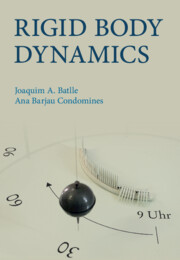Book contents
- Rigid Body Dynamics
- Reviews
- Rigid Body Dynamics
- Copyright page
- Contents
- Preface
- Abbreviations
- 1 Particle Dynamics
- 2 Interaction Forces between Rigid Bodies
- 3 Mass Distribution
- 4 Vector Theorems
- 5 Work–Energy Theorem
- 6 The Method of Virtual Power
- 7 Lagrange’s Equations
- 8 Introduction to Percussive Dynamics
- Bibliography
- Further Reading
- Index
1 - Particle Dynamics
Published online by Cambridge University Press: 21 March 2022
- Rigid Body Dynamics
- Reviews
- Rigid Body Dynamics
- Copyright page
- Contents
- Preface
- Abbreviations
- 1 Particle Dynamics
- 2 Interaction Forces between Rigid Bodies
- 3 Mass Distribution
- 4 Vector Theorems
- 5 Work–Energy Theorem
- 6 The Method of Virtual Power
- 7 Lagrange’s Equations
- 8 Introduction to Percussive Dynamics
- Bibliography
- Further Reading
- Index
Summary
Hypotheses and principles of Newtonian mechanics governing the dynamics of particles. Mach’s "empirical propositions” are presented as an alternative to Newton's laws, and the equivalences between both approaches is analyzed. The fundamental law governing particle dynamics (Newton’s second law) is presented both in Galilean and non-Galilean reference frames. A discussion of the frames which appear to behave as Galilean ones (according to the scope of the problem under study) is also included. The most usual interactions between particles are described. Formulation of forces associated with gravitation, springs, dampers, and friction phenomena are provided. Constraint forces on particles are introduced and characterized.
Keywords
- Type
- Chapter
- Information
- Rigid Body Dynamics , pp. 1 - 78Publisher: Cambridge University PressPrint publication year: 2022

